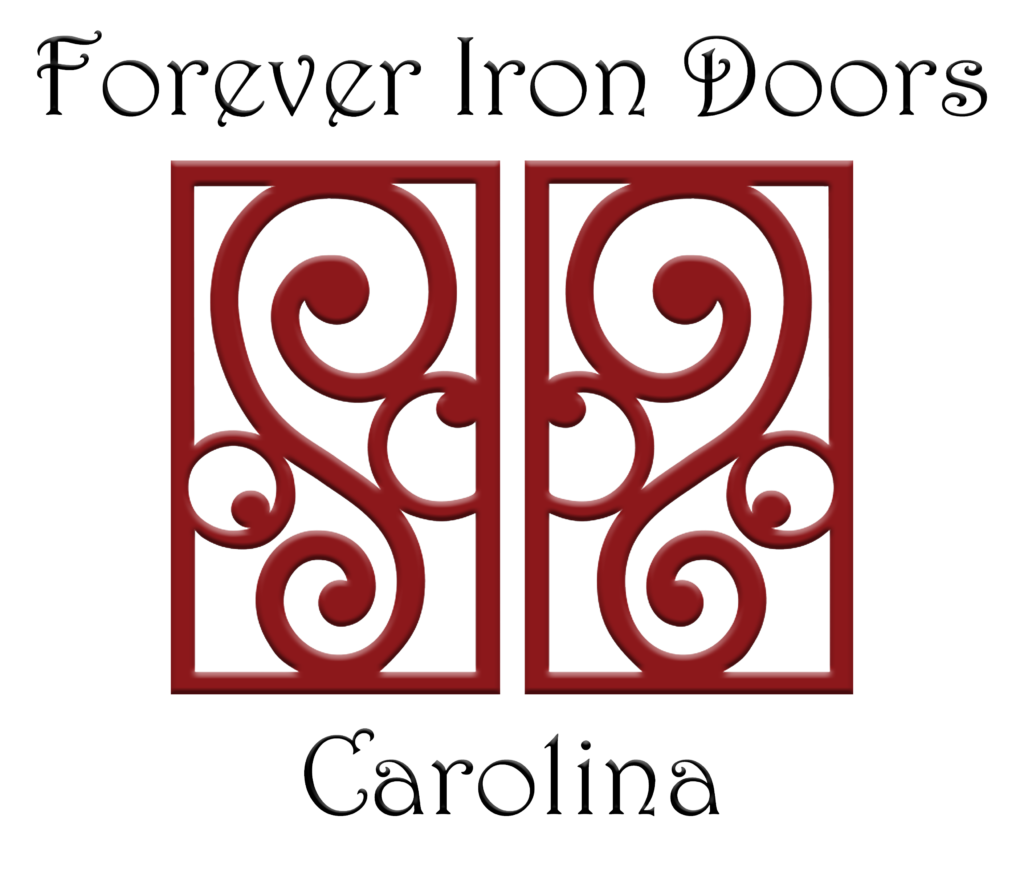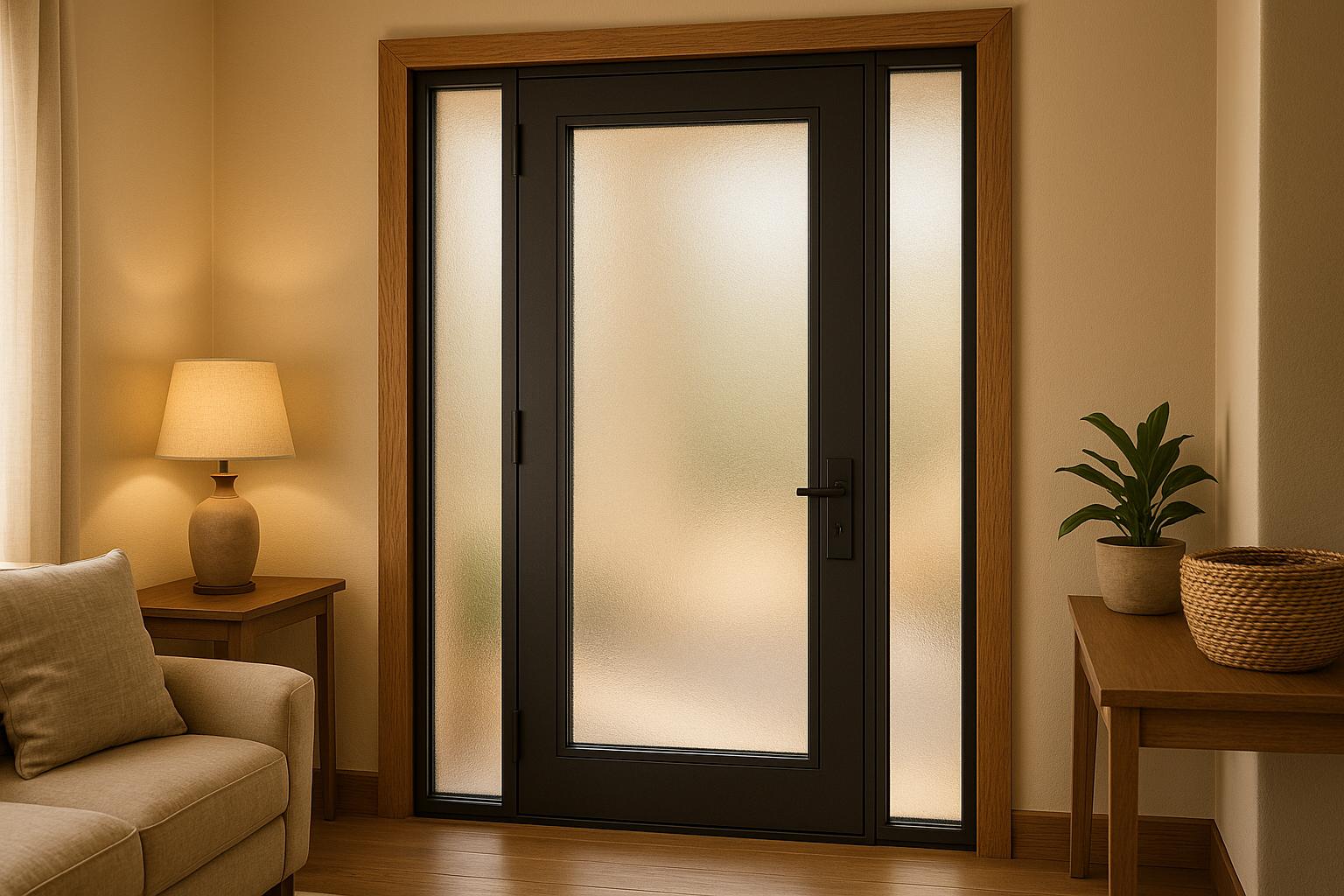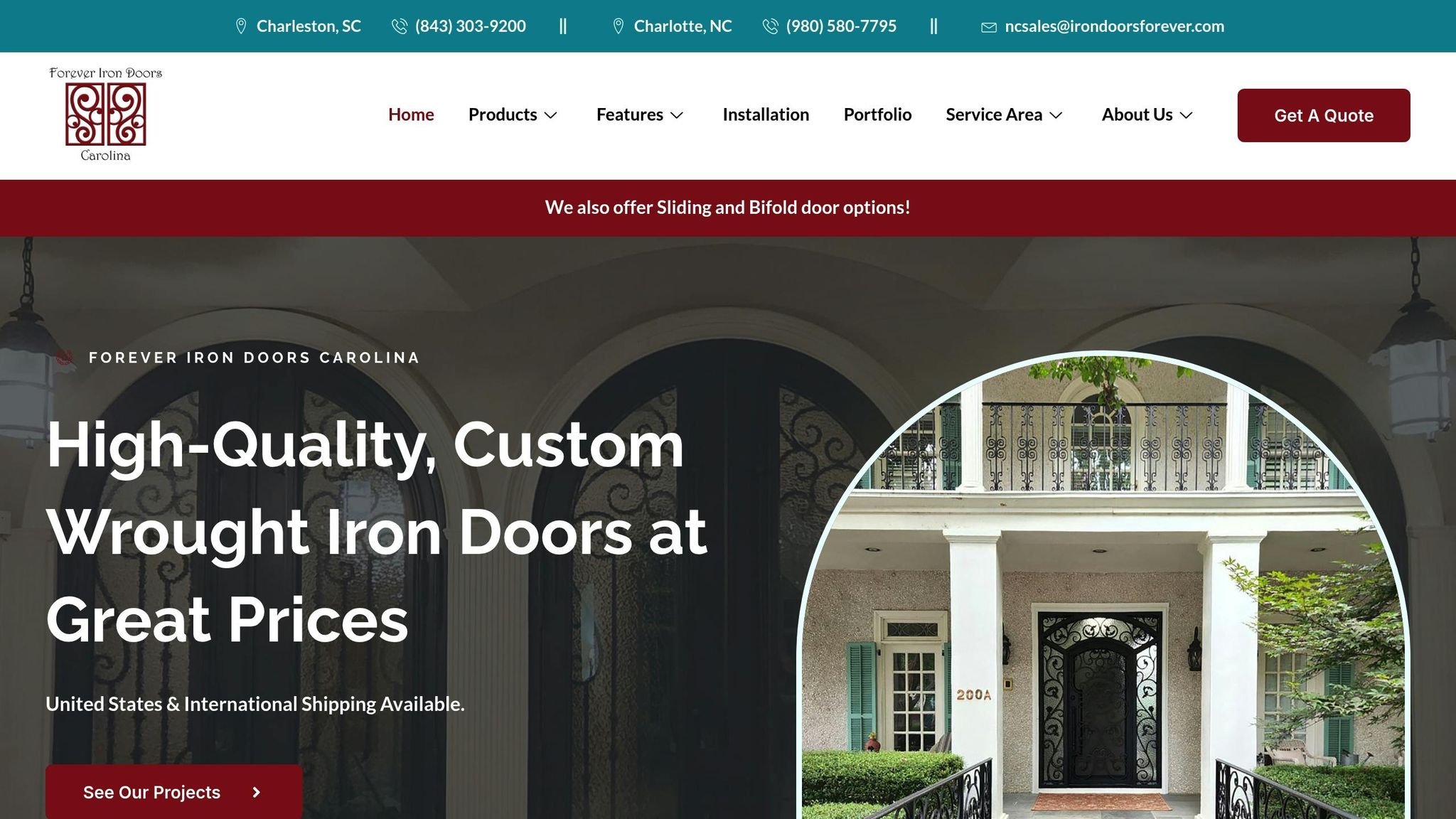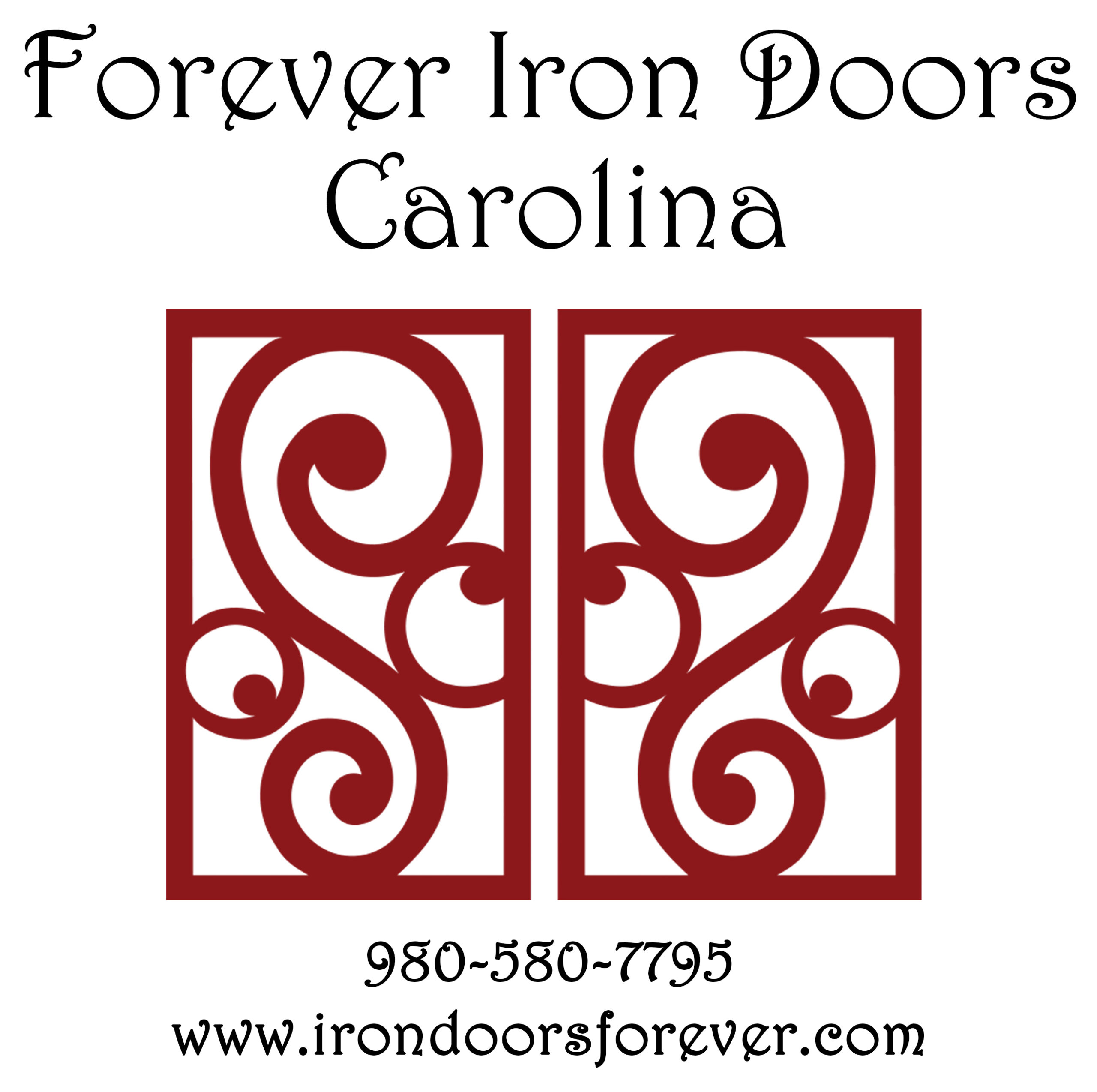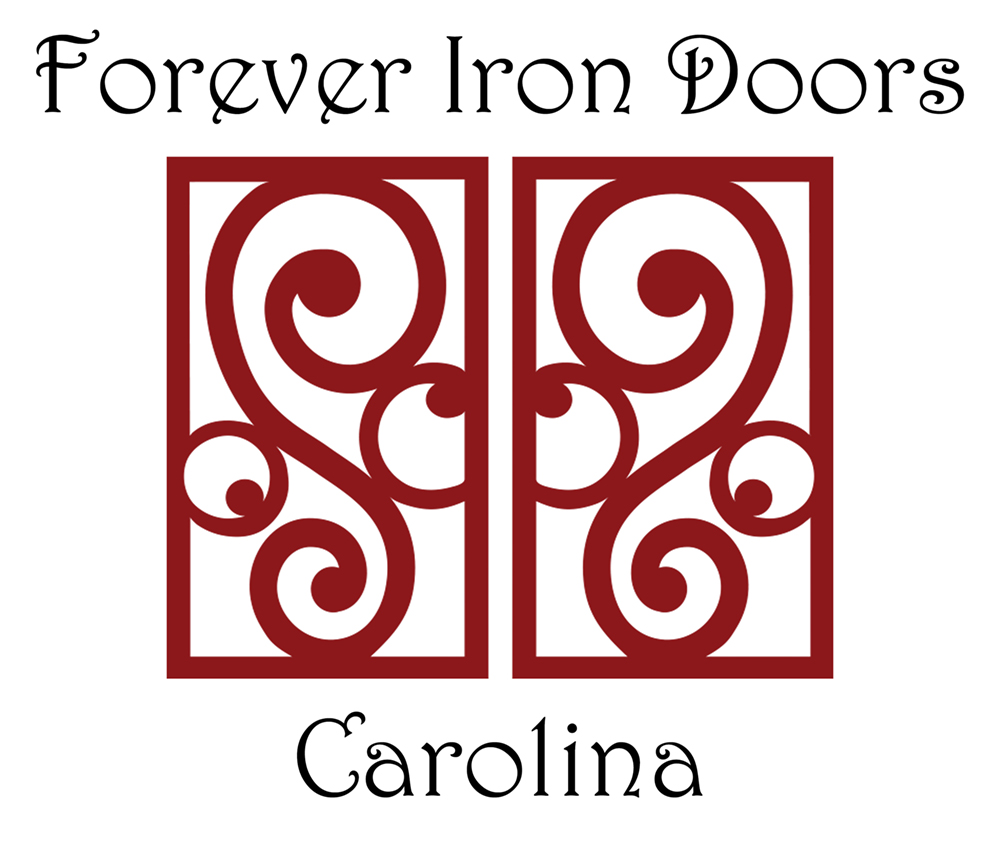Iron doors are more than just a stylish entryway – they can save energy and lower your utility bills. By reducing heat transfer and sealing gaps, these doors help maintain indoor temperatures year-round. Features like insulated glass, polyurethane foam cores, and advanced weather stripping keep air leaks at bay, cutting heating and cooling costs by up to 25%. Plus, many iron doors are crafted from recycled materials, making them a smart choice for energy-conscious homeowners.
Key Highlights:
- Insulated Glass: Double- or triple-pane options with Low-E coatings reduce heat transfer.
- Foam Insulation: Polyurethane foam fills the door frame, boosting insulation and blocking moisture.
- Weather Stripping: Durable EPDM rubber and magnetic seals prevent drafts and air leaks.
- Lower Energy Bills: Homeowners report noticeable savings, especially during extreme weather.
- Durability: Iron doors resist warping and maintain efficiency over time.
Energy-efficient iron doors don’t just improve comfort – they also cut costs and last for years with proper installation. Whether you’re dealing with hot summers or chilly winters, these doors provide excellent thermal performance while enhancing your home’s overall efficiency.
Energy-Efficient Features in Iron Doors
Custom wrought iron doors are designed with advanced features that create an effective thermal barrier. These elements tackle common sources of energy loss while preserving the durability and security that homeowners expect from iron doors. Let’s break down these features and how they contribute to energy efficiency.
Insulated Glass Options
One of the key components of energy-efficient iron doors is insulated glass. Double- and triple-pane glass systems are designed to minimize heat transfer. These systems consist of multiple layers of glass separated by spaces filled with air or gases like argon or krypton, which offer better insulation than regular air.
Low-E coatings further enhance energy performance by reflecting infrared heat while still allowing visible light to pass through. This helps maintain a comfortable indoor temperature – keeping spaces cooler during summer and warmer in winter.
For added safety and insulation, tempered and laminated glass options are available. Laminated glass includes a plastic interlayer that not only boosts security but also provides extra thermal resistance. Glass thickness can vary, with thicker options generally offering even better energy efficiency.
Foam Insulation in Door Structure
The structural components of these doors often include polyurethane foam insulation. This foam is injected into hollow sections of the door frame, expanding to fill gaps and create a seamless thermal barrier.
Closed-cell polyurethane foam is especially effective, offering a high R-value per inch, which measures its insulating capability. Beyond insulation, this foam acts as a vapor barrier, reducing the risk of moisture infiltration that could lead to condensation or diminished insulation performance. By filling irregular shapes and voids, the foam also helps address thermal bridging, which can otherwise allow heat to escape.
Weather Stripping and Sealing
Weather stripping and sealing systems play a crucial role in preventing air and moisture from sneaking through gaps around the door. Iron doors use multiple layers of sealing materials to create a robust weather barrier.
EPDM rubber weather stripping is a standout choice for its durability and flexibility across extreme temperatures. It resists UV rays, ozone, and harsh weather conditions, ensuring long-lasting performance without cracking or shrinking.
Magnetic weather stripping offers an extra layer of protection by using magnets to pull the door tightly against the frame. This ensures a consistent seal, even as the door and frame expand or contract with temperature changes. These magnetic strips are often covered with soft rubber or vinyl, which compresses to fill any small gaps.
At the bottom of the door, adjustable threshold systems enhance sealing by ensuring a snug fit with the door sweep. Many thresholds also include thermal breaks to reduce heat transfer through this critical area.
Together, these sealing techniques create a comprehensive weatherization system that minimizes air leakage from all angles. When professionally installed, these components work seamlessly, ensuring proper alignment and compression for maximum energy efficiency.
Customer Reviews: Energy Efficiency Results
Homeowners have shared their experiences, highlighting measurable energy savings, improved indoor comfort, and better overall home performance. These outcomes stem from the advanced energy-efficient features discussed earlier.
Lower Utility Bills
A common benefit reported by homeowners is a noticeable drop in monthly energy bills after upgrading to energy-efficient entry doors. This is particularly evident during extreme weather conditions, where older, inefficient doors often allowed significant energy loss. Features like insulated cores, thermal breaks, and high-quality weatherstripping act as a strong barrier, reducing the strain on heating and cooling systems. With proper weatherproofing, these upgrades help cut energy costs while maintaining a comfortable indoor environment.
Improved Indoor Comfort
Energy-efficient iron doors also contribute to more consistent indoor temperatures, keeping homes cozy in winter and cool in summer. One homeowner in Oklahoma shared how their insulated iron double doors transformed their home’s seasonal comfort. They no longer experience extreme heat in the summer or cold drafts in the winter, and even noticed a reduction in interior frost buildup. These changes not only enhance comfort but also make the home feel more livable throughout the year.
Prevention of Drafts and Moisture
Another significant improvement noted by customers is the elimination of drafts and moisture, thanks to superior weatherstripping and sealing. Rooms near entryways feel more comfortable year-round, with fewer drafts and balanced moisture levels during both summer and winter. Unlike wood or fiberglass doors, iron doors resist warping, splitting, and delaminating over time, ensuring they retain their structural integrity and energy efficiency. Modern designs with thermal breaks, advanced insulation, and specialized glazing can even rival or surpass the thermal performance of other materials. These features make iron doors a durable and effective choice for energy-conscious homeowners.
sbb-itb-cd90297
How Forever Iron Doors Carolina Builds Energy-Efficient Doors
Forever Iron Doors Carolina crafts its custom doors to handle the unique climate challenges of North and South Carolina. From humid, sweltering summers to cooler winters, their doors are designed to maintain energy efficiency all year long. By combining advanced materials and thoughtful design, they maximize energy performance beyond standard construction practices.
Their custom wrought iron doors incorporate advanced insulation and thermal break technology, creating a strong barrier against energy loss.
Custom Glass and Insulation Features
To boost insulation, the iron frames are injected with polyurethane foam during the manufacturing process. This foam core helps the doors achieve R-values exceeding 6.5 and U-factors as low as 0.24. These figures reflect the door’s ability to resist heat flow, making them highly effective at maintaining indoor temperatures.
The double-pane glass systems are another standout feature. They can include insulating argon gas between the panes to further reduce heat transfer. Additionally, composite panel connectors minimize temperature exchange between the inner and outer door panels. Glass stops securely hold the panels in place, adding another layer of thermal protection. To top it off, high-quality weatherstripping seals every crevice, which is critical since gaps around exterior doors can account for 18–20% of heat loss in most homes.
All these features are meticulously integrated during manufacturing to ensure the doors are ready for precise installation, locking in their energy-saving potential.
Professional Installation Techniques
Even the most energy-efficient door won’t perform as intended without proper installation. Forever Iron Doors Carolina guarantees a flawless fit by relying on certified installers who use precise measurements, sturdy framing, and effective moisture sealing. This attention to detail ensures an airtight seal, preventing energy loss and protecting against the elements. From the initial design to the final installation, every step is carefully executed to deliver maximum energy efficiency for homeowners in the Carolinas.
Benefits of Energy-Efficient Iron Doors
Energy-efficient iron doors can make a noticeable difference in both your energy bills and the comfort of your home by reducing heat transfer and cutting down on energy usage.
These doors are designed with features like effective insulation and quality seals that help prevent energy loss. By limiting drafts and temperature fluctuations, they reduce the need to rely heavily on heating and cooling systems.
What’s more, the durable construction of custom wrought iron doors ensures these energy-saving benefits last for years. With high-quality weather stripping and sealing systems, the doors maintain their efficiency over time, even with regular use.
In regions like the Carolinas, where the weather can shift dramatically, these iron doors help keep indoor temperatures stable year-round. That means a more comfortable home and consistent energy performance, no matter the season.
Custom wrought iron doors not only enhance your home’s energy efficiency but also provide immediate comfort and long-term savings, making everyday living a little easier.
FAQs
How do iron doors with insulated glass and foam insulation improve energy efficiency?
Iron doors equipped with insulated glass and foam insulation are a smart choice for improving your home’s energy efficiency. Insulated glass works by creating a barrier that reduces heat transfer, helping to keep your indoor spaces at a steady temperature. This means you could see a noticeable reduction in your heating and cooling bills.
Foam insulation, typically made from materials like polyurethane with a high R-value, fills in gaps and prevents heat from escaping. This added layer of thermal protection boosts the door’s overall performance. Together, these features not only make your home more comfortable but also help you save on energy costs over time.
What are the long-term advantages of energy-efficient iron doors in areas with extreme weather?
Energy-efficient iron doors come with a range of long-term perks, particularly for those living in areas with extreme weather. These doors are built to limit heat transfer, which helps keep indoor temperatures consistent throughout the year. The result? A more comfortable home and noticeable savings on energy bills.
On top of that, their superior insulation and weatherproofing features guard against rust and corrosion, ensuring they stay durable while maintaining their energy-saving properties. Choosing a well-made iron door means homeowners can benefit from reduced energy costs, long-lasting durability, and reliable protection against tough weather.
How does proper installation improve the energy efficiency of iron doors?
Proper installation is essential to make sure your iron door provides the best energy efficiency. A snug fit, paired with sealing techniques like weatherstripping and insulating materials such as expanding foam, helps block drafts and minimize heat loss. This not only keeps your home cozy throughout the year but also helps lower energy bills by maintaining steady indoor temperatures.
By tackling any potential air leaks during the installation process, you can get the most out of your iron door’s insulation capabilities, making it a smart choice for homeowners looking to save on energy costs.
